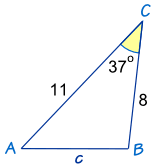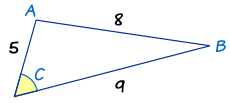Hello! This week I will be covering the cosine law.
What is the cosine law?
Similar to sine law, the cosine law relates the length of the triangles to the cosines of one of the angles. To put that in English, the cosine law states that if the length of two sides and the angle between them is known for a triangle, then we can learn the length of the third side. It helps us solve triangles that we cannot use sine law for.
The law of cosines is: .

Say we were trying to find side c.
First, we input the values that we know into the equation above. This will give us .
Now, we solve for c. I find it easier to do half of the equation before doing the other half as it is quite a long equation. Once you reach , we take the square root so that our
is simplified to a c.
Our answer will end up being c = 6.67.
We can also use the cosine law to find an angle.

Input the values that we know to end up with . From here, we isolate the angle by rearranging. Subtract
and move it over to where
is. From here, we can divide everything but cos(C). To find the angle of a triangle, we use inverse cosine.
Our final answer should be C = 62.2.
Hope this helps!